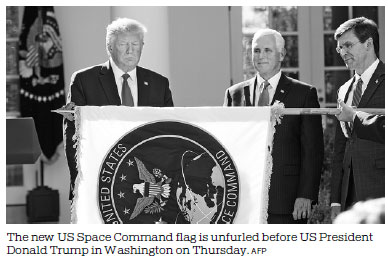New Pentagon command launched for space warfare
WASHINGTON - The US government announced on Thursday the establishment of the US Space Command to defend its interests in space.
"This is a landmark day, one that recognizes the centrality of space to America's security and defense," US President Donald Trump said in a White House ceremony joined by John Raymond, the first commander of US Space Command.
"We are at a strategic inflection point where there is nothing that we do as a joint coalition force that isn't enabled by space," Raymond told reporters at the Pentagon.
"I'm convinced that space is a war-fighting domain. I'm convinced that our way of life and our way of war depend on space capabilities," he said.
Trump ordered the establishment of the Space Command late last year, making it the 11th unified combatant command of the US Department of Defense.
The newly established Space Command is built to "protect America's dominance in space" by "employing assigned forces from every branch of the military" and "delivering combat power by operating superior space capabilities such as communications, intelligence, navigation, and early missile detection and warning", according to a White House statement released on Thursday.
A US Space Command existed from 1985 to 2002, but was disbanded in the aftermath of the Sept 11, 2001, terrorist attacks as the country focused on domestic defense.
The new command is believed to be a step toward building an independent Space Force, a plan that still requires Congress approval.
The US Space Command will soon be followed by the establishment of the United States Space Force as the sixth branch of the United States Armed Forces, according to Trump.
"As a unified combatant command, the United States Space Command is the next crucial step toward the creation of an independent Space Force as an additional armed service," US Secretary of Defense Mark Esper said on Wednesday at a news conference.
One-year transition
The US Defense Department officials had discussed Space Force legislation with Congress, sources told SpaceNews. The Senate proposed a one-year transition before standing up a new military service but the House required no such transition, according to the sources.
The phased-in approach proposed by the Senate came amid concerns over excessive costs and the growth of the military bureaucracy.
"There is no reason to believe that adding an entirely new Space Force bureaucracy and pouring buckets more money into it is going to reduce our overall vulnerability in space," said Senator Elizabeth Warren at a Senate hearing in April.
"In order to achieve the intent of standing up the new force and executing the bill, additional technical and conforming amendments are necessary," said a US Defense Department memo.
Last year the Pentagon elevated its cyber warfare operations to Cyber-Com, recognizing that online attacks and defense constituted a unique theater of combat.
But Trump has a much more ambitious vision for space warfare.
In June 2018, he ordered the US Department of Defense to create a much larger Space Force, a dedicated branch of the military equal to the existing forces, the US Army, Air Force, Navy, Marines and Coast Guard.
Xinhua - Agencies

(China Daily 08/31/2019 page7)














